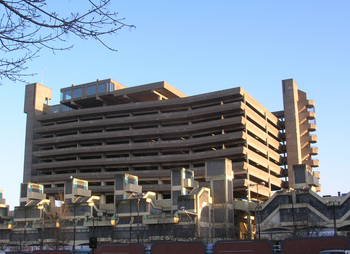IMS_Blog
Because I forget stuff. Part of norcimo.com
Note: It appears you must have reached this page by a deep level URL. In general this site is currently down and unmaintained. See here
About This Post
Originally posted September 26 2007 at 22:09 under General. 0 Comments. Trackbacks Disabled.
An Edifice
- Mood:
- Hoping
- Location:
- The place the car park lives
This post has been a long time in the preparation. The idea for it has been gestating as a (very brief) draft for around a year or more. Recent events have finally brought it into the light of day. It’s taken some quite significant (for the medium) additional time after deciding to release it for me to fully write it, trying to form each part of my thoughts into a coherent whole and gathering various resources and references. Take heed of the warning—compared to almost anything else around here it’s long.
I’m not that necessarily much of an architecture nut, more of a building person, if that makes sense. I like castles of course, and I appreciate some buildings are wonderful but I wouldn’t say I go around drooling. I do think heritage is important though, and that we shouldn’t be too quick to discard everything today’s trend says is bad, lest tomorrow’s people miss it (something which, for instance, this fairly recent Financial Times article—which briefly mentions the subject of this post—takes up). We should be particularly careful of doing so in the name of (financially driven) “progress”. Tearing things apart is an easy option, often much easier than utilising what is there, but it is only after doing so that you realise you must still find some replacement that not only matches but betters what you had—and that what you had is now lost forever. Perhaps a combination of these things is why I believe Gateshead should not lose its car park.
As I mentioned, this is going to be quite a long piece and as such I feel I should make a couple of things clear at the start. I am not advocating a stagnation, a status quo of sliding degradation. Nor am I claiming that the infamous car park in it’s current form is a worthy or useful building. Of course we need progress, I just don’t happen to think that should be blindly driven by grabbing the largest pot of cash to follow the path of least resistance. Nor can it go unremarked that the current state of the infamous car park is at least in part due to a systematic neglect by the local authority, designed to place it into just such a state that its eventual demolition becomes easier to justify. I’ve said we need progress, and it is progress that I advocate, but progress without the wholesale ripping apart of one of the few historic cultural focuses available to build upon.
Some History
The history of the car park has become well known and, in many ways, itself tells the tale of the last four decades of Gateshead. The car park, and associated market and shopping centre, was designed by Owen Luder, who went on to be president of the Royal Institute of British Architects (who incidently are just a little down the road from the IOP). Ironically, the “Trinity Centre” was conceived as a redevelopment of Gateshead town centre, a (with hindsight somewhat ill judged) attempt to compete with the consumer shopping offerings of central Newcastle just a short hop across the Tyne. The car park towering at the heart of the centre perfectly fits with this concept, offering a consumer driven vision more familiar to modern eyes from out of town centres (replete with their own multi-stories). Opened in 1967 the centre never really fulfilled its role, always remaining in the shadow of its across river neighbour. The failure of its rooftop restaurant to ever open reflecting the failure of much of anything to emerge in its surrounds. In time the Trinity Centre was superseded by Newcastle’s own Eldon Square shopping centre, built with the benefit of a decade’s experience and existing user base, and eventually by those very out of town experiences (such as Gateshead’s own Metrocentre) which it had in its way provided an early, doomed glimpse of.
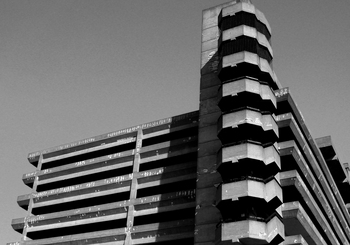
Broken dreams: The degradation of the car park seems in many ways to represent the lost ideas of the past [Photo by mojo-jo-jo, Creative Commons Attribution License]
From the bright hopes of the 1960s the car park’s crumbling reflects that of the world around it. As mines and industry slowly but surely closed what had been a physical grimness became a more personal one, and the car park’s façade seemed to fall with the faces of those desperate around it. That which is neglected will of course fail, and the car park, never seeing the influx of consumers to serve its purpose, was neglected, a reminder of shattered dreams. In some ways I think this is partly why it is so loathed by some—it is not because it is a great lump of concrete (it is a great lump of concrete), or because they think it’s more ugly than some of the other things around it. It’s because it represents those broken visions, now stands for the destruction of the bright outlook it once stood so grandly for. So they would destroy it, force into the darkness where they hide those youthful, forward looking and so long lost hopes.
The Get Carter Connection
It seems to be impossible to have any discussion of the Trinity Square Shopping Centre Multi-story Car Park without at least once referring to it by its more well known, and catchier, moniker—the Get Carter Car Park. For while the car park didn’t become known as a shopping haven it did become widely recognised for its prominent appearance in 1971’s seminal British film Get Carter. I really don’t want to say much about the connection, as unavoidable as comment is. I believe the car park can stand on its own merits without a movie nostalgia boost. However, there is one thing Get Carter has given the car park; that is an instant recognition and association with Gateshead. It is one of the very few structures almost always immediately recognised as Gateshead, rather than Newcastle or even simply the “north east” (something neither the Sage, Baltic or, for obvious reasons, the Millennium Bridge can claim. Probably the only thing which gets close is Gormley’s Angel of the North, which is hardly central). That connection, the instant location awareness, I think is an important point which is undervalued, as I’ll expand upon below.
Architectural Importance of the Car Park
The Get Carter connection is far from the only reason the preservation of the car park. Quite apart from the sheer short sightedness of throwing away what we have for the sake of Tesco or some other off the shelf retail product, the car park has in fact become architecturally important. As a piece of brutalistic architecture it is a very fine example. It’s also one of a rapidly declining number of extant examples. The Trinity Centre’s big brother Tricorn Centre in Portsmouth has already been lost, along with most of the rest of an entire style. In fact as long as demolition proposals have been around (which is actually several years) organisations such as the Twentieth Century Society have been pointing out the importance of the car park, making it one of their Risky Buildings, and defended by those with vision. It’s certainly more debated than the council would make out.
Decline And Rebirth
As time moved on the already mentioned decline continued in the centre of Gateshead almost unchecked. Whilst Newcastle got its Eldon Square and a stuttering but continual progress Gateshead got a public transport interchange, which simply facilitated leaving—given the lack of any encouragement to stay—to visit Newcastle or the newly sprung Metrocentre. Indeed as the Metrocentre and Garden Festival helped regenerate some of the scourged by industry surrounding areas nothing was done for a centre simply scourged by time. The car park became even more of a white elephant, and the problem became that, really, no one cared. Its surrounding collection of low grade stores towered over by this slowly decaying giant seemed the perfect representation of the crumbling degradation around it. The car park became accompanied by murmurings of “tear it down and start again”, but it was never clear if such gripes were really directed at the car park or life itself.
Thankfully that has, in many ways, changed. Out of the fall of those decades Gateshead has bounced back, though it has finally had to admit that it must ride itself somewhat on the shoulders of its better known, livelier neighbour, now modelling the combined city and town as NewcastleGateshead. It is by the city, on the river banks, that the true renaissance of the southern portion of NewcastleGateshead has started (though one has to wonder just how much that would have happened had Newcastle’s quayside not undergone its own transformation, leaving those with disposable income staring across the river and wondering at what they saw). Partly to symbolise this new joining of the two sides of the Tyne we gained the impressive new Millennium Bridge, which has already become something of an icon. Architecture was obviously also high on the agenda when constructing the Sage music centre. The third grand symbol of this regeneration forms an interesting point alongside the car park debate. The Baltic is an example of what you can do with a large, derelict and useless building, that many would say ought to simply be swept aside to facilitate progress. Here someone has had the vision to realise that it’s inherent qualities can lend to and enhance it’s eventual use for something never envisioned in its original conception (indeed, it’s builders would probably have assumed it would be simply knocked down once its working life was over). Before its transformation the Baltic was basically unheard of, and hardly the most attractive building. This imaginative redeployment may well be something to bear in mind as I discuss the car park more below. Another example of reusing old buildings can be seen just down the road from the car park (in fact adjacent to the entrance ramp). Here the old cooperative building, itself something of a symbol for so many years, is being repurposed. It’s not exactly the most lovely looking building, yet it’s being preserved. Of course there’s money in doing so (thank you Argos, et al), so suddenly preservation rather than “progressive” destruction is the order of the day.
So Why Not The Car Park?
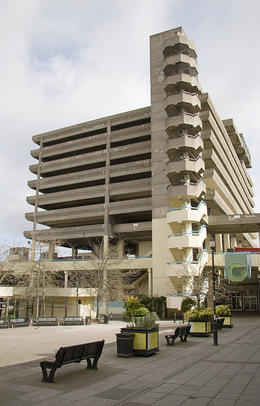
The current state of the car park and surrounding square. Note the awful masonry paint, patched up concrete and unchecked graffiti. [Photo by Les Bessant, Creative Commons Attribution, No-derivative, Non-commercial License]
The simple answer is that the council have long since decided that is the way it will be. It is an easy popularity win to point to what is currently there and say it is bad. Doing so though ignores that part of the problem is a circular argument. The state of the car park, and surroundings, are such in part because that’s how they’ve been allowed to become by those in charge, so that they could point to that very state and say it is bad. The council knows the real estate they have, and have always known its value to a big player like Tesco. So they have neglected to do anything about any of the real problems. They painted the bottom few layers of the car park (and the shopping centre) in a completely unsuitable yellow-cream masonry paint, yet left the rest. They patch the worst failing parts of the car park knowing it will give ugly patches against the neglected dull grey, yet do not probably investigate the possibility of actual repairs. They still advertise the car park on their car parks list but make no efforts to bring it up to today’s standards (improved lighting, modernised lifts…) The shops around it become neglected and yet we hear of no great incentive schemes; in fact the council have long made it as clear as they dare that they look down upon the trinity shopping centre, knowing full well how much that will put off potential businesses—which of course leads to empty units and more circular arguing. In the end they got their big pay deal and could sell the whole problem on.
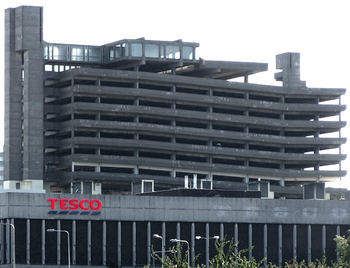
Tesco and the car park (and the rest of central Gateshead) seem to be inextricably linked. [Source photo by Project 71, Creative Commons Attribution License]
Interestingly enough, this isn’t the first time Tesco has taken over an historic building in Gateshead. In the 1980s it acquired Shephards, eventually tearing it down, strangely enough to make a car park. Despite the fact that the Shephards building was itself a somewhat ugly and monolithic structure, there was, and still occasionally is, a feeling of it being missed, replaced by nothing of great worth. Yet Tesco are allowed to do essentially the same thing with one of the few historic and iconic, and architecturally important, buildings remaining in the centre of Gateshead (name another which fits those criteria, go on). Perhaps the council like Tesco so much because their own civic centre looks so much like a giant hypermart!
The Town Centre Strategy
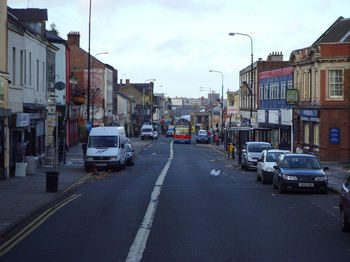
There’s no arguing that regeneration is needed. The question is how to go about it [Photo by thierry1498, Creative Commons Attribution, Non-Commercial, Non-Derivative License]
There is another reason to save the car park’s future, other than its architectural importance, instant recognisability and sheer potential. It might actually fit better with the council’s stated strategy for the town centre (PDF) than the proposed developments. As well as seemingly crazier suggestions like Allow for potential future cable car link to the Quays from a central accessible terminus in the town centre
(page 20) (which would benefit from a conveniently tall building…), that planning strategy contains such ideas as:
- Provide a major arts/cultural ‘attractor’ in the town centre, which may be in the form of art in the public realm, or a building, which provides a major ‘draw’ to the town centre. (pg 11—emphasis mine)
- Any proposed ‘big box’ development, where unavoidable, should either; be of sufficiently high quality and appropriately located within the town centre context to warrant the status of ‘landmark’; or, absorbed into the existing scale of the urban grain by building under street level or by wrapping its perimeter with smaller scale units that will enhance the sense of continuity and enclosure and relate to the scale of the streetscape. (pg 11—of course, it is avoidable, and difficult to see how a Tesco fits in)
- A building, which may be an attractor due to its unique and distinctive design or because it is a landmark structure. (pg 16—emphasis mine)
- If Gateshead is able to find a unique selling point, this could provide additional reason for people to visit the town centre. (pg 16)
- In addition to this there is the opportunity to substantially increase height within the central core area of the town centre to create a focus that will visually landmark Central Gateshead within the context of Central Tyneside and the Tyne Gorge. This could be either a single iconic structure or a cluster of structures. (pg 12—emphasis mine)
- Introduce small businesses and other contemporary uses into old buildings and railway arches (pg 7—emphasis mine)
You may see a pattern in the above quotations. Basically the plan in part calls for the very thing that the car park is, and points the way to possible ideas to use it better (as I’ll discuss below). It’s very hard to envisage yet another Tesco producing any of the things above, apart from the “big box” development which it specifically calls for the avoidance of where possible. There are actually a couple of more points I’d like to draw out from the planning strategy.
- The town centre contains significant listed buildings, conservation areas and other historic buildings. When these areas are preserved and/or enhanced, buildings improved and occupied with suitable long-term users, and public spaces improved, they can make a positive contribution to the town centre, providing variation in building and townscape form, connection with the past and a sense of place. (pg 6–7—emphasis mine)
- Redevelopment and/or selective improvement of both sides of the High Street, and Charles Street car park. There may be cases where a block of existing property may remain … there are a few buildings of local architectural and historic interest which it would be desirable to retain
This shows the contempt in which the council actually holds the car park. It simply doesn’t want to acknowledge that it has any significance at all. While it may be understandable that the car park is not listed (and that’s not a clear cut decision), it doesn’t even make the local list, which seems ridiculous. There’s also the terribly ironic mention above of the improvement of a car park. Indeed the strategy further says The provision of adequate levels of secure, conveniently located parking should be a central element of any redevelopment proposals … As far as possible car parking should be provided for the town centre as a whole. Car parking exclusively dedicated to individual retail outlets should be avoided
(pg 10—emphasis mine). In other words car parking is needed in the centre somewhere, and we should try to avoid people like Tesco building their own car parking provisions…objectives which seem unlikely to be met with Tesco running the show.
By now the attentive reader will have no doubt surmised that it is my position that the planning strategy would be better met not by tearing the car park down but by maintaining it and utilising it as an historically significant, recognisable landmark feature. That is indeed my position. However, I believe that the capitulation of the council to the lure of big business investment money goes beyond a simple lack of vision for regenerating the car park, to the point where it threatens the very essence of the regeneration plans. Consider this final point from the strategy document:
The aspiration is for Gateshead Town Centre to be a vibrant and distinctive part of an enlarged NewcastleGateshead City Centre serving the region. There needs to be good reason to visit Gateshead (pg 15—emphasis mine)
(there are more problems with the document I could pick up, but that’s really beyond the scope of this post).
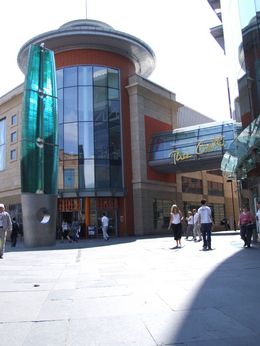
The Gate Newcastle, with it’s bars, parking, restaurants and cinema. Watch out for diversity! [Photo by Stephen Moretti, Creative Commons Attribution, Non-Commercial, No Derivatives License]
The still scanty details we have for the proposals are summarised on this page. Consider the following list of features:
- Restaurants, cafes and bars
- A cinema
- Retail premises
- Public car parking
- A hotel
- Homes and apartments
The problem with the above list is that it is not that for the centre of Gateshead. Rather it is that for the Gateshead Quays 2 development. It does bear a stunning resemblance to the feature list for the central development though. There too cafes and restaurants, a cinema and parking, apartments and, of course, retail are all mentioned. Where then is that distinctive vision? There is a strong argument that the Gateshead Quays development is a lot more closely linked to the already accomplished redevelopment of the Gateshead quayside personified by the likes of the Sage and Baltic, which in turn forms the link to the “NewcastleGateshead city centre” (not to mention the clear similarity to what’s available in the already well established centre of Newcastle itself). Does such an overlap of vision then really give anyone not already there a good reason to visit the centre of Gateshead, however well you improve the transport links with cable cars?
Alternatives
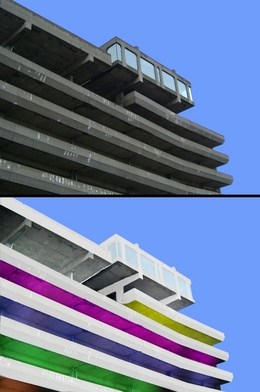
A quick photoshop mockup showing how a lick of paint and some lights would help. [Source photo by LHOON, Creative Commons Attribution, Share Alike]
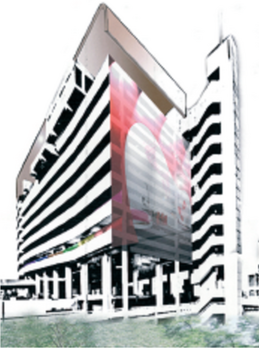
A reimagined car park from the Nottingham Trent workshop (Source: Nottingham Trent Grapevine, vol 21, num 6, pg 8)
Rather than tearing down what they have available to them the council could rejuvenate the car park, celebrate it, make it a beacon for the town centre. Even a quick photoshop knockup shows what a difference a coat of paint and decent lights would make. Of course all that would cost money. Tearing it down costs quite a lot of money too, actually, but there’s a difference. Tesco have waved the magic cheque book. Make no mistake, this isn’t a decision based on culture, or appearance, or even on a desire to follow the best path for regeneration. It is a purely financial one, driven in part by necessity maybe but driven by the money none the less. It’s not even that hard to imagine a regeneration—in fact it’s so easy students can do it. With ironic timing the day before the local press announced the planned demolition they had carried a story about a design student’s revisioning of the car park (produced as part of her Northumbria University course work). It’s not even the first time someone has seen the potential either. A couple of years ago a group of Nottingham Trent University students took part in a design workshop, organised by The Twentieth Century Society, which looked at ways to breath new life into the car park. Again a number of innovative ideas were put forward, including actually using the car park to house the new Tesco. [I’m almost sure there has been a third, earlier, study of a similar nature, but I can’t find a link now I go looking, and don’t seem to have it bookmarked]. One can’t help but wonder, if the students are capable of producing such ideas, what would happen if the council actually put some proper effort into finding new uses, new ways to reinvigorate the building. It could become a true marker for a region, a leading example of how to reuse buildings, of giving them new life and purpose.
Conclusions and a call
Ask yourself: When people talk of Gateshead what should we have them say? “That’s the place with the really cool car park, Trinity” or “Well, er, they’ve got a big supermarket”? The council have well and truly set their course to aim for the latter of those two options, with determination to ignore any and all objections. Not that they’re at all clear exactly what we’re supposed to be getting in the car park’s place (other than the inevitable Tesco). Apparently we’re going to get a road show so we can comment (as if the council hasn’t basically decided already). That might be nice given that the Trinity Square website set up until very recently offered nothing beyond the initial press release, and now begs for support while providing some vague sketches which offer a vision of unimaginative, safe buildings unlikely to stand out amoung the hundreds of others around the country. There is a multinational backed determination to remove the car park, and put in place whatever is most profitable, never mind road shows or proposals.
There is still a chance here. The car park is still standing—there have been no explosions, no wrecking balls, and it recently gained another stay of execution. The council can still see the potential and rescue a magnificent structure by giving it a new innovative lease of life. They need us to tell them loudly to do it though. This might be the sunset for the car park, or maybe it can be a new sunrise.
Comments (0):
Post a comment
Name and email address are required. Email address is never shown. If you enter a URL your name will be linked to it (this and other links will have the rel attribute set to contain nofollow). Markup allowed: <a href="" title="" rel=""> <em> <strong> <abbr title=""> <acronym title=""> <p> <br />. Anything else is stripped; please be valid. Single linebreaks automatically convert to <br />, double to <p>'s. Additionally anything that looks like a bare URL should get automagically linked. Many acronyms and abbreviations are also automagically handled.
Please note this blog's comment policy
Trackbacks (0):
Trackback URL: http://www.norcimo.com/MT/mt-tb.cgi/526
© Ian Scott. Powered by Movable Type 3.2. This blog uses valid XHTML 1.0 Strict and valid CSS. All times are local UK time. For further details see the IMS_Blog about page.. All my feeds in one.
